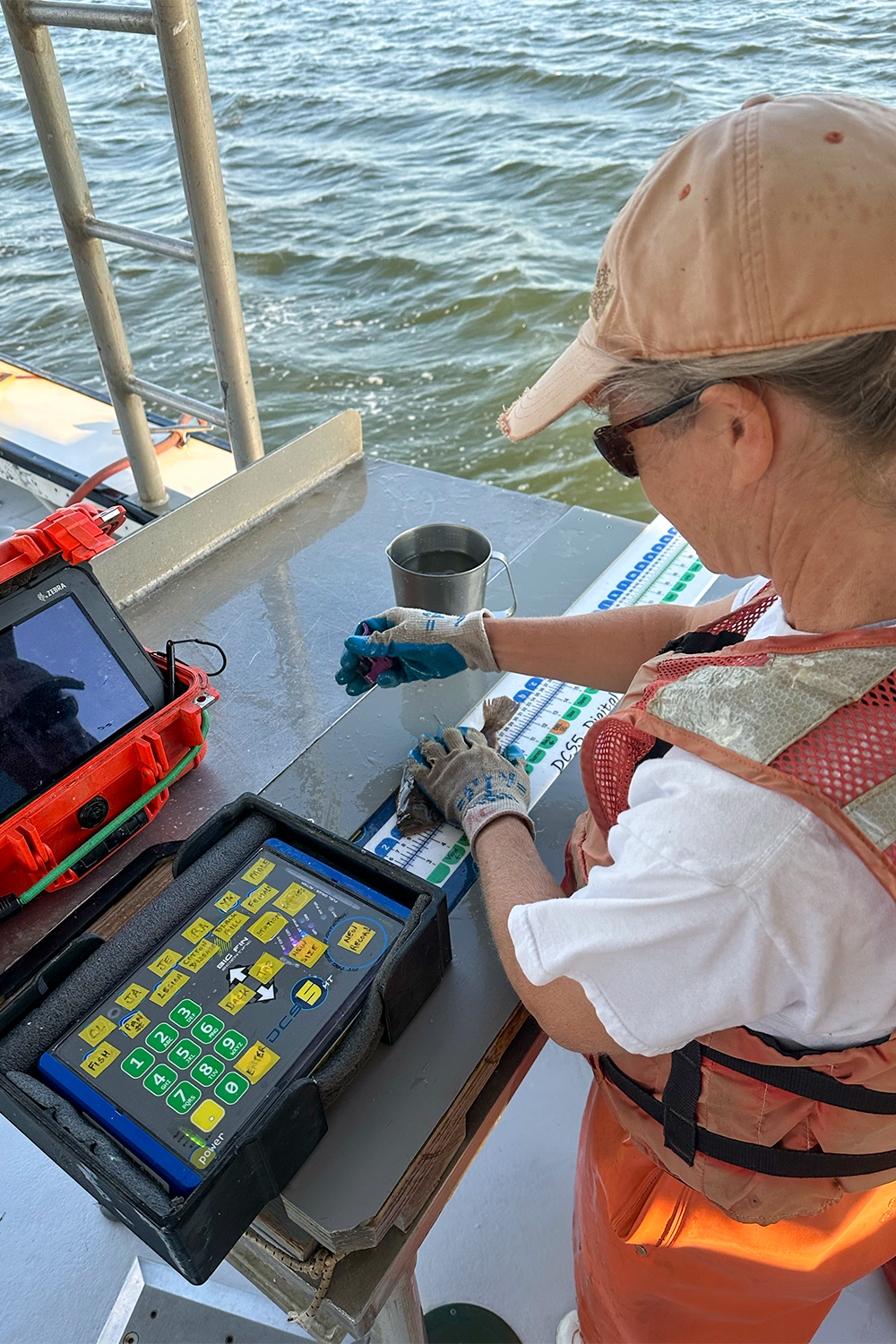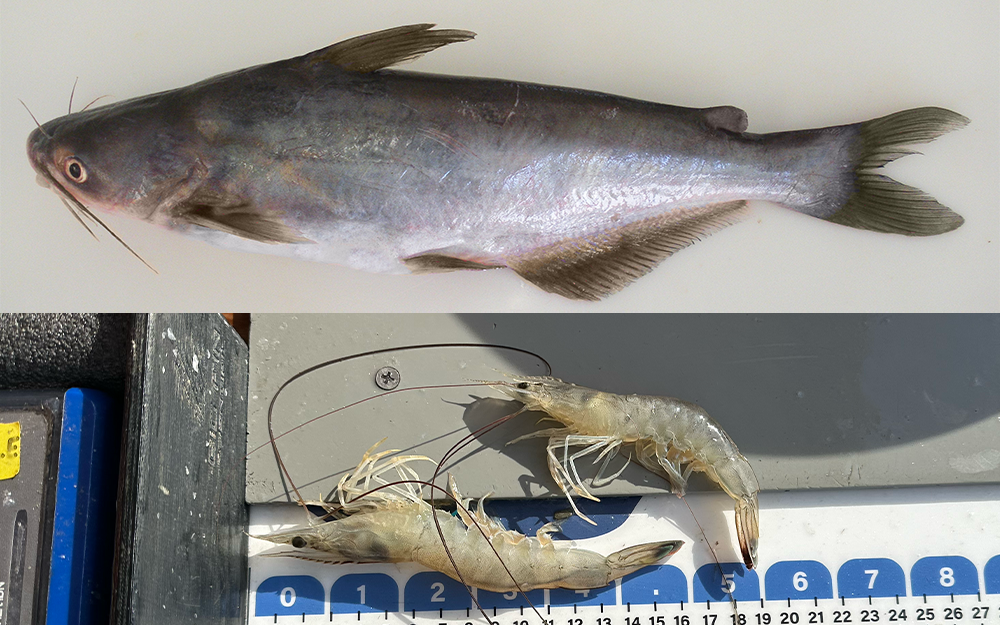Trawling through time: 70 years of the Juvenile Finfish Trawl Survey
The Batten School & VIMS regularly monitor Chesapeake Bay species, including the invasive blue catfish
 For seven decades, William & Mary's Batten School & VIMS have built one of the most important data sets in fisheries science: the Juvenile Finfish Trawl Survey. Launched in 1955, the survey now monitors more than 1,200 sites each year across the lower Chesapeake Bay and its tributaries, providing ongoing snapshots of the region’s fish populations. These long-term data are critical for ecological understanding and fisheries management.
For seven decades, William & Mary's Batten School & VIMS have built one of the most important data sets in fisheries science: the Juvenile Finfish Trawl Survey. Launched in 1955, the survey now monitors more than 1,200 sites each year across the lower Chesapeake Bay and its tributaries, providing ongoing snapshots of the region’s fish populations. These long-term data are critical for ecological understanding and fisheries management.
“The basic point of the survey is to monitor juvenile fishes over time and use consistent methodologies so we can compare one year to the next in perpetuity,” said Troy Tuckey, a senior research scientist. That consistency enables scientists and managers to distinguish sustained trends from natural fluctuations. “Nature doesn’t respond in a year,” Tuckey noted, “so you need a long-term perspective.”
 The trawl survey began with limited sampling in the York River, but it gradually expanded to include the James and Rappahannock Rivers, as well as the Chesapeake Bay proper. “It’s morphed over time,” said Mary Fabrizio, a professor at the Batten School of Coastal & Marine Sciences & VIMS. “Now it's much more in tune with the needs of fisheries and fishery management.”
The trawl survey began with limited sampling in the York River, but it gradually expanded to include the James and Rappahannock Rivers, as well as the Chesapeake Bay proper. “It’s morphed over time,” said Mary Fabrizio, a professor at the Batten School of Coastal & Marine Sciences & VIMS. “Now it's much more in tune with the needs of fisheries and fishery management.”
Today, the team gathers samples monthly using a five-minute tow of a 20-foot net to collect thousands of juvenile fish. “We skim right across the bottom, but we don't trawl over areas where we know there are sponges, sea grass, oysters or other obstructions,” said Tuckey. “We're trying to observe nature, then put it back in place and move on. We identify 'em, meaure 'em, toss 'em overboard.”
That low-impact, high-value method produces data that inform stock assessments for species ranging from summer flounder to blue crabs, among many others. “Resource managers use the survey data to make their decisions, but our work is the fundamental science upstream of the management component,” Tuckey clarified.
Over the decades, the trawl survey has documented major ecological shifts. “Climate change is affecting the Chesapeake Bay, and we’re seeing fishes respond to those changes,” said Fabrizio. “We're also able to document when an invasive species arrives in the system, how it becomes established and then how it might spread.”
 One such invasive species is the infamous blue catfish, introduced in the 1970s by the Virginia Department of Game and Inland Fisheries. “They thought it was a good idea to establish a recreational fishery. Unfortunately, no one wondered what the consequences would be literally downstream,” Fabrizio explained.
One such invasive species is the infamous blue catfish, introduced in the 1970s by the Virginia Department of Game and Inland Fisheries. “They thought it was a good idea to establish a recreational fishery. Unfortunately, no one wondered what the consequences would be literally downstream,” Fabrizio explained.
The trawl survey has not only recorded the rise of the blue catfish but also the correlated decline of native fish occupying similar habitats. “That is a clear signal that we have found from the survey data,” said Fabrizio. “As blue catfish increase, native white catfish decrease.”
“They’ve just flatlined,” Tuckey confirmed. “It’s the same with white perch. For the past several years, we haven't seen any, in any of the rivers. That's really concerning.”
While continuing to increase in the York River, the blue catfish population does seem to have plateaued in the James and Rappahannock Rivers. However, Tuckey cautioned, “their numbers have flattened out, but at a really high level. There's a lot of blue catfish.”
Informed by survey data, the Virginia Marine Resources Commission (VMRC) recently eliminated a size limit on blue catfish, allowing anglers to keep the largest specimens. The VMRC has also approved permits for commercial watermen to test targeted electrofishing, allowing them to stun and harvest blue catfish with minimal impacts to native species.
Another newcomer to the Bay is the white shrimp, which is not invasive, but arrived as waters have warmed and now supports a commercial industry. “The data from the survey supported the opening of a shrimp fishery, which is a cool outcome,” said Tuckey.
 As the climate shifts and fish populations change, the trawl survey is also evolving. A newly modernized research vessel enables state-of-the-art collection, while a recently approved five-year funding cycle promises greater stability. “Now we can breathe easier, do our work and plan for the future,” Fabrizio said. “We’ve come a long way.”
As the climate shifts and fish populations change, the trawl survey is also evolving. A newly modernized research vessel enables state-of-the-art collection, while a recently approved five-year funding cycle promises greater stability. “Now we can breathe easier, do our work and plan for the future,” Fabrizio said. “We’ve come a long way.”
The trawl survey will also continue as a vital research platform for graduate students who help staff the survey. “I’ve loved going out and learning with the trawl team,” said first-year graduate student Aileen McDonald. “I’m very excited to use the data for my research.”
As one of the longest continuously running fish surveys in the nation, the Juvenile Finfish Trawl Survey continues to be a pivotal and influential operation in the Bay and beyond, informing citizens and policymakers up and down the East Coast. Motivated by that success and propelled by the dedicated scientists at the Batten School & VIMS, the trawl survey will carry on its crucial work for decades to come.

